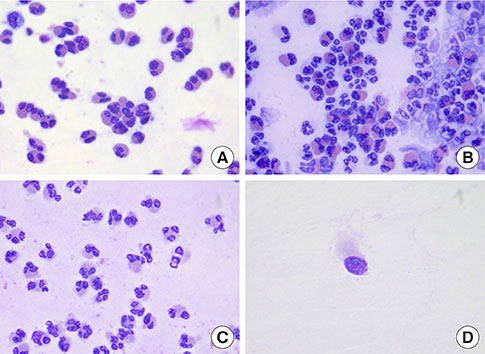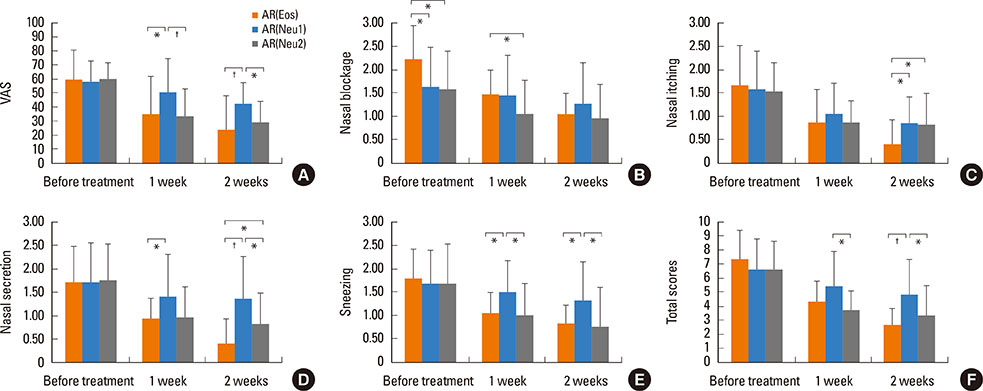Allergy Asthma Immunol Res.
2017 Sep;9(5):403-409. 10.4168/aair.2017.9.5.403.
Individualized Treatment of Allergic Rhinitis According to Nasal Cytology
- Affiliations
-
- 1Department of Otorhinolaryngology, Union Hospital, Tongji Medical College, Huazhong University of Science and Technology, Wuhan, China. entwjkong@hust.edu.cn
- 2Division of Allergy, Department of Internal Medicine, Morsani College of Medicine, University of South Florida, Tampa, FL, USA.
- KMID: 2383987
- DOI: http://doi.org/10.4168/aair.2017.9.5.403
Abstract
- PURPOSE
Nasal cytology is important in the diagnosis and treatment of nasal inflammatory diseases. Treatment of allergic rhinitis (AR) according to nasal cytology has not been fully studied. We plan to explore the individualized treatment of AR according to nasal cytology.
METHODS
Nasal cytology from 468 AR patients was examined for inflammatory cell quantity (grade 0-5) and the percentage of neutrophils and eosinophils. Results were subdivided into the following categories: AR(Eos), eosinophil ≥50% of the whole inflammatory cells; AR(Neu), neutrophils ≥90%; AR(Eos/Neu), 10%≤ eosinophil <50%; AR(Low), grade 0/1 inflammatory cell quantity. Nasal cytology-guided treatment was implemented: all AR(Eos) patients (n=22) and half of the AR(Neu) patients (AR[Neu1], n=22) were treated with mometasone furoate spray and oral loratadine. Another half of the AR(Neu) patients (AR[Neu2], n=22) were treated with oral clarithromycin. Visual analog scale (VAS), symptom scores, and nasal cytology were evaluated 2 weeks before and after treatment.
RESULTS
There were 224/468 (47.86%) AR(Eos), 67/468 (14.32%) AR(Neu), 112/468 (23.93%) AR(Eos/Neu), and 65/468 (13.89%) AR(Low) of the AR patients studied. There were no significant differences in clinical characteristics among these subgroups, except that the nasal blockage score was higher in AR(Eos) patients than in AR(Neu) patients (1.99 vs. 1.50, P=0.02). Comparing AR(Eos) patients with AR(Neu1) patients 2 weeks after treatment, nasal symptoms and VAS were significantly lower in AR(Eos) patients, except for nasal blockage symptoms (P<0.05 of nasal itching and sneezing; P<0.01 for nasal secretion, total scores, and VAS). Comparing AR(Neu1) with AR(Neu2) patients, nasal symptoms, and VAS were significantly lower in AR(Neu2), except for nasal blockage and nasal itching symptoms (P<0.05 for nasal secretions, sneezing, total score, and VAS).
CONCLUSIONS
Nasal cytology may have important value in subtyping AR and optimizing AR treatment. Treating neutrophils is very important in AR patients with locally predominant neutrophils.
Keyword
MeSH Terms
Figure
Cited by 1 articles
-
The Relevance of Nasal Cytology in the Workup of House Dust Mite-Induced Allergic Rhinitis
Matteo Gelardi, Paola Puccinelli, Cristoforo Incorvaia, Giovanni Passalacqua, Giorgio Ciprandi,
Allergy Asthma Immunol Res. 2018;10(3):283-284. doi: 10.4168/aair.2018.10.3.283.
Reference
-
1. Gelardi M, Iannuzzi L, Quaranta N, Landi M, Passalacqua G. NASAL cytology: practical aspects and clinical relevance. Clin Exp Allergy. 2016; 46:785–792.2. Pipkorn U, Karlsson G. Methods for obtaining specimens from the nasal mucosa for morphological and biochemical analysis. Eur Respir J. 1988; 1:856–862.3. Mygind N. Essential allergy. Oxford: Blackwell Scientific Publications;1986.4. Bousquet J, Schünemann HJ, Samolinski B, Demoly P, Baena-Cagnani CE, Bachert C, et al. Allergic Rhinitis and its Impact on Asthma (ARIA): achievements in 10 years and future needs. J Allergy Clin Immunol. 2012; 130:1049–1062.5. Howarth PH. Eosinophils and rhinitis. Clin Exp Allergy Rev. 2005; 5:55–63.6. Foley SC, Hamid Q. Images in allergy and immunology: neutrophils in asthma. J Allergy Clin Immunol. 2007; 119:1282–1286.7. Gounni AS, Lamkhioued B, Koussih L, Ra C, Renzi PM, Hamid Q. Human neutrophils express the high-affinity receptor for immunoglobulin E (Fc epsilon RI): role in asthma. FASEB J. 2001; 15:940–949.8. Alphonse MP, Saffar AS, Shan L, HayGlass KT, Simons FE, Gounni AS. Regulation of the high affinity IgE receptor (Fc epsilonRI) in human neutrophils: role of seasonal allergen exposure and Th-2 cytokines. PLoS One. 2008; 3:e1921.9. Hauber HP, Gotfried M, Newman K, Danda R, Servi RJ, Christodoulopoulos P, et al. Effect of HFA-flunisolide on peripheral lung inflammation in asthma. J Allergy Clin Immunol. 2003; 112:58–63.10. Fukakusa M, Bergeron C, Tulic MK, Fiset PO, Al Dewachi O, Laviolette M, et al. Oral corticosteroids decrease eosinophil and CC chemokine expression but increase neutrophil, IL-8, and IFN-gamma-inducible protein 10 expression in asthmatic airway mucosa. J Allergy Clin Immunol. 2005; 115:280–286.11. Benson M, Strannegård IL, Wennergren G, Strannegård O. Interleukin-5 and interleukin-8 in relation to eosinophils and neutrophils in nasal fluids from school children with seasonal allergic rhinitis. Pediatr Allergy Immunol. 1999; 10:178–185.12. Canakcioglu S, Tahamiler R, Saritzali G, Alimoglu Y, Isildak H, Guvenc MG, et al. Evaluation of nasal cytology in subjects with chronic rhinitis: a 7-year study. Am J Otolaryngol. 2009; 30:312–317.13. Piacentini GL, Kaulbach H, Scott T, Kaliner MA. Evaluation of nasal cytology: a comparison between methods. Allergy. 1998; 53:326–328.14. Gelardi M, Peroni DG, Incorvaia C, Quaranta N, De Luca C, Barberi S, et al. Seasonal changes in nasal cytology in mite-allergic patients. J Inflamm Res. 2014; 7:39–44.15. Özgür A, Arslanoğlu S, Etıt D, Demıray U, Önal HK. Comparison of nasal cytology and symptom scores in patients with seasonal allergic rhinitis, before and after treatment. J Laryngol Otol. 2011; 125:1028–1032.16. Ciprandi G, Buscaglia S, Pesce G, Pronzato C, Ricca V, Parmiani S, et al. Minimal persistent inflammation is present at mucosal level in patients with asymptomatic rhinitis and mite allergy. J Allergy Clin Immunol. 1995; 96:971–979.17. Kim EH, Lee JS, Lee NR, Baek SY, Kim EJ, Lee SJ, et al. Regulation of constitutive neutrophil apoptosis due to house dust mite allergen in normal and allergic rhinitis subjects. PLoS One. 2014; 9:e105814.18. Xuekun H, Qintai Y, Yulian C, Gehua Z. Correlation of gammadelta-T-cells, Th17 cells and IL-17 in peripheral blood of patients with allergic rhinitis. Asian Pac J Allergy Immunol. 2014; 32:235–239.19. Fransson M, Benson M, Wennergren G, Cardell LO. A role for neutrophils in intermittent allergic rhinitis. Acta Otolaryngol. 2004; 124:616–620.20. Benson M, Strannegård IL, Strannegård O, Wennergren G. Topical steroid treatment of allergic rhinitis decreases nasal fluid TH2 cytokines, eosinophils, eosinophil cationic protein, and IgE but has no significant effect on IFN-gamma, IL-1beta, TNF-alpha, or neutrophils. J Allergy Clin Immunol. 2000; 106:307–312.21. Pelucchi A, Chiapparino A, Mastropasqua B, Marazzini L, Hernandez A, Foresi A. Effect of intranasal azelastine and beclomethasone dipropionate on nasal symptoms, nasal cytology, and bronchial responsiveness to methacholine in allergic rhinitis in response to grass pollens. J Allergy Clin Immunol. 1995; 95:515–523.22. Djukanović R, Homeyard S, Gratziou C, Madden J, Walls A, Montefort S, et al. The effect of treatment with oral corticosteroids on asthma symptoms and airway inflammation. Am J Respir Crit Care Med. 1997; 155:826–832.23. Meltzer EO, Orgel HA, Rogenes PR, Field EA. Nasal cytology in patients with allergic rhinitis: effects of intranasal fluticasone propionate. J Allergy Clin Immunol. 1994; 94:708–715.24. Rak S, Jacobson MR, Sudderick RM, Masuyama K, Juliusson S, Kay AB, et al. Influence of prolonged treatment with topical corticosteroid (fluticasone propionate) on early and late phase nasal responses and cellular infiltration in the nasal mucosa after allergen challenge. Clin Exp Allergy. 1994; 24:930–939.25. Barnes PJ. Therapeutic approaches to asthma-chronic obstructive pulmonary disease overlap syndromes. J Allergy Clin Immunol. 2015; 136:531–545.





